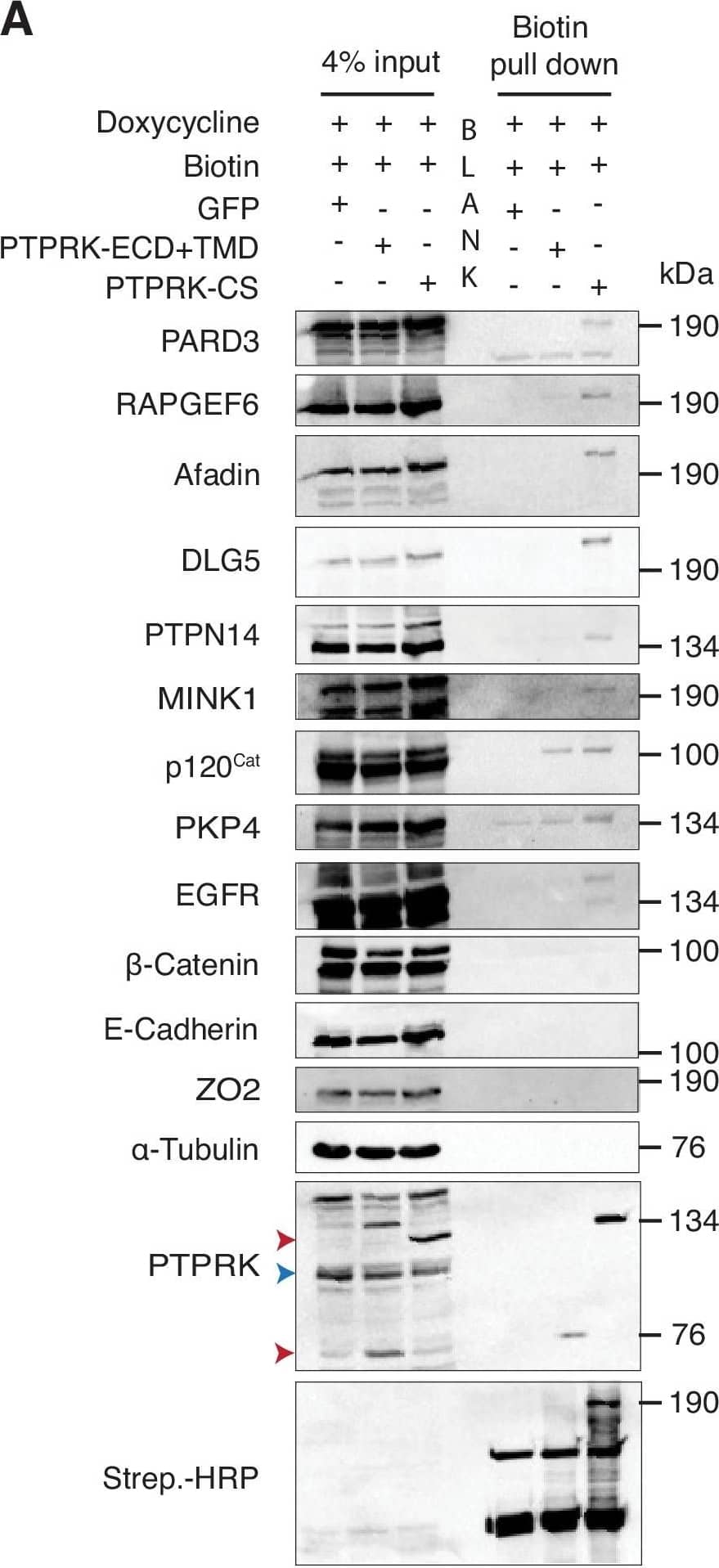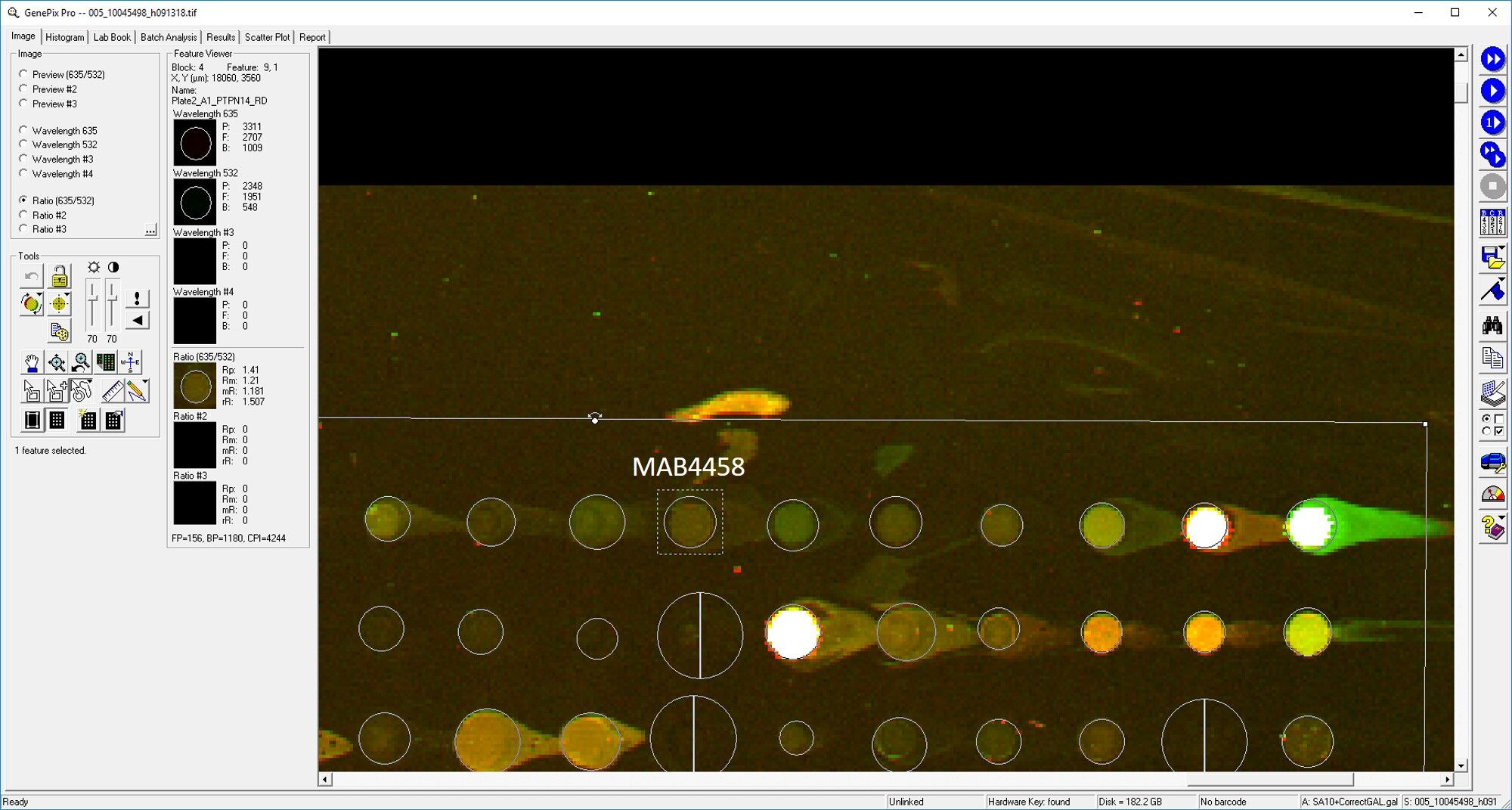Human PTPN14 Antibody Summary
Leu329-Leu900
Accession # Q15678.2
Applications
Please Note: Optimal dilutions should be determined by each laboratory for each application. General Protocols are available in the Technical Information section on our website.
Scientific Data
 View Larger
View Larger
Detection of Human PTPN14 by Western Blot. Western blot shows lysates of DU145 human prostate carcinoma cell line, HT-29 human colon adenocarcinoma cell line, and HT-29 human colon adenocarcinoma cell line. PVDF membrane was probed with 1 µg/mL of Human PTPN14 Monoclonal Antibody (Catalog # MAB4458) followed by HRP-conjugated Anti-Mouse IgG Secondary Antibody (Catalog # HAF007). A specific band was detected for PTPN14 at approximately 135 kDa (as indicated). This experiment was conducted under reducing conditions and using Immunoblot Buffer Group 1.
 View Larger
View Larger
PTPN14 in Human Placenta. PTPN14 was detected in immersion fixed paraffin-embedded sections of human placenta using Human PTPN14 Monoclonal Antibody (Catalog # MAB4458) at 25 µg/mL overnight at 4 °C. Tissue was stained using the Anti-Mouse HRP-DAB Cell & Tissue Staining Kit (brown; Catalog # CTS002) and counterstained with hematoxylin (blue). View our protocol for Chromogenic IHC Staining of Paraffin-embedded Tissue Sections.
 View Larger
View Larger
Detection of Human PTPN14/PTPD2 by Western Blot PTPRK interacts with candidate substrates in confluent MCF10A cells.(A) Representative immunoblot analysis of biotin pull downs from MCF10As expressing tGFP or PTPRK BioID constructs. See Materials and methods for details. Red and blue arrows indicate exogenous and endogenous PTPRK, respectively. (B) Quantification of BioID immunoblots. Green bars indicate the number of times a protein was enriched on PTPRK-C1089S.BirA*-Flag, compared to PTPRK.ECD +TMD.BirA*-Flag in separate experiments. Purple bars indicate the number of times a protein was not enriched or was not detected in any pull downs. n ≥ 1. (C) Schematic representation of PTPRK proximity-labeling by BioID. PTPRK extracellular domain homology model is based on PTPRM (PDB: 2V5Y; Aricescu et al., 2007). Proteins within the dotted lines were detected in pull downs from indicated BioID lysates. Proteins not detectably biotinylated are listed on the left. Proteins in bold and italics were previously identified as PTPRK interactors using BioID in HEK293 cells (St-Denis et al., 2016). See also Figure 4—figure supplement 1.Localization of PTPRK BioID proteins.(A) MCF10As with stably integrated doxycycline-inducible expression constructs (PTPRK-ECD +TMD-BirA*-Flag and PTPRK-C1089s-BirA*-Flag) were treated with 150 ng/ml and 500 ng/ml doxycycline, respectively, and immunostained using an anti-Flag antibody. F-actin and nuclei were stained with phalloidin and Hoechst, respectively. Scale bars = 50 µm. (B) Representative immunoblot analysis of biotin pull downs from MCF10As expressing tGFP or PTPRK BioID constructs. See Materials and methods for details. Red and blue arrows indicate exogenous and endogenous PTPRK, respectively. * residual ABLIM3 signal. Image collected and cropped by CiteAb from the following open publication (https://pubmed.ncbi.nlm.nih.gov/30924770), licensed under a CC-BY license. Not internally tested by R&D Systems.
 View Larger
View Larger
Detection of Human PTPN14/PTPD2 by Immunocytochemistry/ Immunofluorescence PTPN14 is a negative regulator of YAP. C) 293A cells transduced with lentivirus encoding dox-inducible PTPN14 expression. YAP localization in control&PTPN14-expressing cell lines was analysed 72 hours post dox induction by IF at low density using confocal miroscopy. Image collected & cropped by CiteAb from the following open publication (https://pubmed.ncbi.nlm.nih.gov/23613971), licensed under a CC-BY license. Not internally tested by R&D Systems.
 View Larger
View Larger
Detection of Human PTPN14/PTPD2 by Western Blot The interactome of the homophilic adhesion receptor PTPRK. (F–G) Selected PTPRK interactors identified by mass spectrometry validated by immunoblot analysis. Input&supernatants reveal the extent of protein depletion by recombinant proteins. Arrow indicates relevant band. See also Figure 2—figure supplements 1, 2&3. Image collected & cropped by CiteAb from the following open publication (https://pubmed.ncbi.nlm.nih.gov/30924770), licensed under a CC-BY license. Not internally tested by R&D Systems.
 View Larger
View Larger
Detection of Human PTPN14/PTPD2 by Western Blot YAP-PTPN14 binding is mediated through the WW domain-PPxY motif interaction.D) An SF268 cell line stably expressing the YAP-responsive MCAT_Luc reporter was transduced with lentivirus encoding for the indicated dox-inducible PTPN14 expression. Luciferase expression of each cell line was analysed 72 hours post dox induction (left panel). A Resazurin assay was carried out in parallel for each sample&used to normalize the luciferase readings. PTPN14 expression levels achieved for each construct analysed by WB (right panel; arrows indicate the WT PTPN14 protein&the truncated delta PTP PTPN14 which migrates faster; all lanes from a single blot&exposure). Tubulin serves as loading control. Luciferase results are shown as the average of at least 3 independent experiments ± STDEV. Statistical analysis was carried out with a 2-tailed paired t-test; * p<0.05. Image collected & cropped by CiteAb from the following open publication (https://pubmed.ncbi.nlm.nih.gov/23613971), licensed under a CC-BY license. Not internally tested by R&D Systems.
 View Larger
View Larger
Detection of Human PTPN14/PTPD2 by Western Blot In vitro dephosphorylation assays and generation of RPTP chimeras.(A) The indicated PTPRK and PTPRM domains were assayed for phosphatase activity using the pNPP colorimetric assay. Control wells contained pNPP only. Protein amounts used are shown. (B) Pervanadate-treated MCF10A lysates were incubated with predetermined amounts of the indicated domains to give equal phosphatase-activity, prior to phosphotyrosine immunoprecipitation and immunoblot analysis. (C) Recombinant proteins consisting of combinations of PTPRK and PTPRM D1 and D2 domains were expressed in and using Ni-NTA affinity resin. Purified proteins were then subjected to size exclusion chromatography. (D) Recombinant His- and Avi-tagged PTPRK and PTPRM chimeric domains were purified from E. coli cultured in biotin-supplemented media, incubated ±streptavidin and subjected to SDS-PAGE and Coomassie staining, to determine the extent of biotinylation. Arrows indicate the purified domains and the respective streptavidin-induced mobility shift. (E) The indicated recombinant PTPRK and PTPRM chimeric domains were incubated were assayed for phosphatase activity using the pNPP colorimetric assay. Control wells contained pNPP. Protein amounts used are shown. Image collected and cropped by CiteAb from the following open publication (https://pubmed.ncbi.nlm.nih.gov/30924770), licensed under a CC-BY license. Not internally tested by R&D Systems.
 View Larger
View Larger
Detection of Human PTPN14/PTPD2 by Western Blot YAP-PTPN14 binding is mediated through the WW domain-PPxY motif interaction. F) 293A cells transduced with lentivirus encoding for the indicated dox-inducible PTPN14 expression. The nuclear/cytoplasmic YAP ratio was quantified at low density after 72 hours of dox induction using a Cellomics automated imager with a conventional microscope,&expressed relative to control (left panel). Results are shown as the average of three experiments ± STDEV. Statistical analysis was carried out with a 2-tailed paired t-test; * p<0.05. For each experiment, the average ratio was calculated from three wells per sample (10 images per well). PTPN14 expression levels analysed by WB (right panel; arrows indicate the WT PTPN14 protein&the truncated delta PTP PTPN14 which migrates faster; all lanes from a single blot&exposure). Tubulin serves as a loading control. Image collected & cropped by CiteAb from the following open publication (https://pubmed.ncbi.nlm.nih.gov/23613971), licensed under a CC-BY license. Not internally tested by R&D Systems.
 View Larger
View Larger
Detection of Human PTPN14/PTPD2 by Western Blot PTPN14 is a negative regulator of YAP.B) An SF268 cell line stably expressing the YAP-responsive MCAT_Luc reporter was transduced with lentivirus encoding for dox-inducible PTPN14 expression. After pharmacological selection, luciferase expression was measured for both cell lines in the presence&absence of dox (upper panel). A Resazurin assay was carried out in parallel for each sample&used to normalize the luciferase readings. Results are shown as the average of three independent experiments ± STDEV. Statistical analysis was carried out with a 2-tailed paired t-test; * p<0.0001. RLU: relative luciferase units. PTPN14 expression achieved by dox&YAP levels in each sample was analyzed by WB (lower panel). Tubulin serves as loading control. Image collected & cropped by CiteAb from the following open publication (https://pubmed.ncbi.nlm.nih.gov/23613971), licensed under a CC-BY license. Not internally tested by R&D Systems.
Reconstitution Calculator
Preparation and Storage
- 12 months from date of receipt, -20 to -70 °C as supplied.
- 1 month, 2 to 8 °C under sterile conditions after reconstitution.
- 6 months, -20 to -70 °C under sterile conditions after reconstitution.
Background: PTPN14
Protein Tyrosine Phosphatase, Non-receptor type 14 (PTPN14), also called Phosphatase with Ezrin Domain (PEZ) and PTP36, is a 135 kDa cytosolic protein that dephosphorylates tyrosine residues in proteins. PTPN14’s Ezrin domain is homologous to erythrocyte Band 4.1 protein, targeting the phosphatase to cytoskeletal elements such as actin. PTPN14 associates with beta-catenin in adhesion zones in cells that are touching, but is nuclear in isolated, proliferating cells. Loss-of-function mutations in PTPN14 are found in 26% of colorectal cancers, suggesting it is a tumor suppressor.
Product Datasheets
Citations for Human PTPN14 Antibody
R&D Systems personnel manually curate a database that contains references using R&D Systems products. The data collected includes not only links to publications in PubMed, but also provides information about sample types, species, and experimental conditions.
9
Citations: Showing 1 - 9
Filter your results:
Filter by:
-
The Tyrosine Phosphatase PTPN14 Is a Negative Regulator of YAP Activity
Authors: Chrysiis Michaloglou, Waltraut Lehmann, Typhaine Martin, Clara Delaunay, Andreas Hueber, Louise Barys et al.
PLoS ONE
-
The homophilic receptor PTPRK selectively dephosphorylates multiple junctional regulators to promote cell–cell adhesion
Authors: Gareth W Fearnley, Katherine A Young, James R Edgar, Robin Antrobus, Iain M Hay, Wei-Ching Liang et al.
eLife
-
A proximity proteomics screen in three-dimensional spheroid cultures identifies novel regulators of lumen formation
Authors: LT Wang, MÈ Proulx, AD Kim, V Lelarge, L McCaffrey
Scientific Reports, 2021-11-23;11(1):22807.
Species: Human
Sample Types: Cell Lysates, Whole Cells
Applications: IHC, Western Blot -
The non-receptor tyrosine phosphatase type 14 blocks caveolin-1-enhanced cancer cell metastasis
Authors: NI Díaz-Valdi, J Díaz, P Contreras, A Campos, V Rojas-Celi, RA Burgos-Rav, L Lobos-Gonz, VA Torres, VI Perez, B Frei, L Leyton, AFG Quest
Oncogene, 2020-03-09;0(0):.
Species: Human
Sample Types: Cell Lysates
Applications: Western Blot -
The effect of YAP expression in tumor cells and tumor stroma on the prognosis of patients with squamous cell carcinoma of the oral cavity floor and oral surface of the tongue
Authors: J Szelachows, P Donizy, K Ratajczak-, A Halon, D Zielecka-D, K Lichon, A Maciejczyk, E Lata-Wozni, A Piotrowska, R Matkowski
Oncol Lett, 2019-07-31;18(4):3561-3570.
Species: Human
Sample Types: Whole Tissue
Applications: IHC-P -
Protein-tyrosine Phosphatase and Kinase Specificity in Regulation of SRC and Breast Tumor Kinase.
Authors: Fan G, Aleem S, Yang M, Miller W, Tonks N
J Biol Chem, 2015-04-20;290(26):15934-47.
Species: Human
Sample Types: Cell Lysates
Applications: Western Blot -
A novel phosphatidic acid-protein-tyrosine phosphatase D2 axis is essential for ERBB2 signaling in mammary epithelial cells.
Authors: Ramesh M, Krishnan N, Muthuswamy S, Tonks N
J Biol Chem, 2015-02-13;290(15):9646-59.
Species: Human
Sample Types: Cell Lysates
Applications: Western Blot -
Protein-tyrosine phosphatase 1B antagonized signaling by insulin-like growth factor-1 receptor and kinase BRK/PTK6 in ovarian cancer cells.
Authors: Fan G, Lin G, Lucito R, Tonks N
J Biol Chem, 2013-06-28;288(34):24923-34.
Species: Human
Sample Types: Cell Lysates
Applications: Western Blot -
YAP modifies cancer cell sensitivity to EGFR and survivin inhibitors and is negatively regulated by the non-receptor type protein tyrosine phosphatase 14.
Authors: Huang JM, Nagatomo I
2012-06-11;0(0):.
Species: Human
Sample Types: Cell Lysates
Applications: Western Blot
FAQs
No product specific FAQs exist for this product, however you may
View all Antibody FAQsReviews for Human PTPN14 Antibody
Average Rating: 4 (Based on 3 Reviews)
Have you used Human PTPN14 Antibody?
Submit a review and receive an Amazon gift card.
$25/€18/£15/$25CAN/¥75 Yuan/¥2500 Yen for a review with an image
$10/€7/£6/$10 CAD/¥70 Yuan/¥1110 Yen for a review without an image
Filter by:


